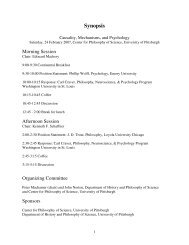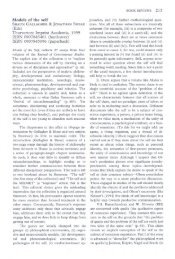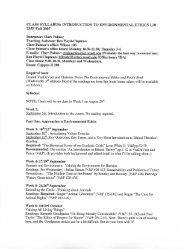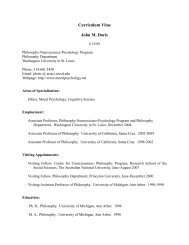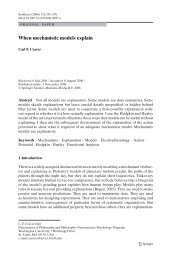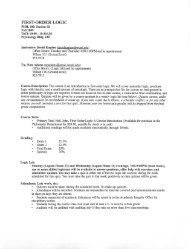The Blackwell Guide to the Philosophy of Science - The Department ...
The Blackwell Guide to the Philosophy of Science - The Department ...
The Blackwell Guide to the Philosophy of Science - The Department ...
You also want an ePaper? Increase the reach of your titles
YUMPU automatically turns print PDFs into web optimized ePapers that Google loves.
Interpreting Quantum <strong>The</strong>ories<br />
13 Ma<strong>the</strong>matical nicety demands that <strong>the</strong> quantum field be cast not (as <strong>the</strong> foregoing<br />
suggests) as a map from space–time points <strong>to</strong> opera<strong>to</strong>rs, but as opera<strong>to</strong>r-valued distributions<br />
over space–time regions. Wald (1994) is an excellent introduction <strong>to</strong> this<br />
and o<strong>the</strong>r issues discussed in this section.<br />
14 No<strong>to</strong>riously, it even breaks down in a subset <strong>of</strong> Minkowski space–time. Positive energy<br />
states correspond <strong>to</strong> solutions <strong>to</strong> <strong>the</strong> Klein–Gordon equation that oscillate with purely<br />
positive frequency. States in <strong>the</strong> standard Minkowski representation are positive frequency<br />
with respect <strong>to</strong> time as measured by families <strong>of</strong> inertial observers. But restricting<br />
our attention <strong>to</strong> <strong>the</strong> right Rindler wedge <strong>of</strong> two-dimensional Minkowski<br />
space–time setting c = 1, this is <strong>the</strong> region where x is positive and |x| < t – we can<br />
quantize <strong>the</strong> Klein-Gordon field by admitting solutions that oscillate with positive frequency<br />
with respect <strong>to</strong> time as measured by observers whose accelerations are constant,<br />
for Lorentz boost isometries generate a global time function for <strong>the</strong> Rindler<br />
wedge. <strong>The</strong> Rindler representation we <strong>the</strong>reby obtain has a natural particle interpretation<br />
– but <strong>the</strong> Rindler representation is unitarily inequivalent <strong>to</strong> <strong>the</strong> Minkowski representation!<br />
This is sometimes, and loosely, expressed as <strong>the</strong> Unruh effect: observers<br />
accelerating through <strong>the</strong> Minkowski vacuum “see” a <strong>the</strong>rmal flux <strong>of</strong> particles (Wald,<br />
1994, ch. 5).<br />
References<br />
Albert, D. (1992): Quantum Mechanics and Experience. Cambridge, Mass: Harvard.<br />
Albert, D. and Loewer, B. (1988): “Interpreting <strong>the</strong> Many Worlds Interpretation,”<br />
Syn<strong>the</strong>se, 77, 195–213.<br />
Albert, D. and Loewer, B. (1996): “Tails <strong>of</strong> Schrödinger’s Cat,” in R. Clif<strong>to</strong>n (1996,<br />
pp. 81–92).<br />
Arageorgis, A., Earman, J. and Ruetsche, L. (2001): “Weyling <strong>the</strong> Time Away: <strong>The</strong><br />
Non-Unitary Implementability <strong>of</strong> Quantum Field Dynamics on Curved Space–time and<br />
<strong>the</strong> Algebraic Approach <strong>to</strong> Quantum Field <strong>The</strong>ory,” Studies in His<strong>to</strong>ry and <strong>Philosophy</strong> <strong>of</strong><br />
Modern Physics, forthcoming.<br />
Bacciagaluppi, G. and Hemmo, M. (1996): “Modal Interpretations, Decoherence and<br />
Measurements,” Studies in <strong>the</strong> His<strong>to</strong>ry and <strong>Philosophy</strong> <strong>of</strong> Modern Physics, 27B, 239–77.<br />
Bell, J. (1964): “On <strong>the</strong> Einstein–Podolsky–Rosen Paradox,” Physics, 1, 195–200.<br />
Reprinted in Wheeler and Zurek (1983, pp. 403–8).<br />
Bell, J. (1966): “On <strong>the</strong> Problem <strong>of</strong> Hidden Variables in Quantum Mechanics,” Reviews<br />
<strong>of</strong> Modern Physics, 38, 447–52. Reprinted in Wheeler and Zurek (1983, pp. 397–402).<br />
Bell, J. (1987): Speakable and Unspeakable in Quantum Mechanics. Cambridge: Cambridge<br />
University Press.<br />
Belot, G., Earman, J. and Ruetsche, L. (1999): “<strong>The</strong> Hawking Information Loss Paradox:<br />
<strong>The</strong> Ana<strong>to</strong>my <strong>of</strong> a Controversy,” British Journal for <strong>the</strong> <strong>Philosophy</strong> <strong>of</strong> <strong>Science</strong>, 50, 189–229.<br />
Bohm, D. (1951): Quantum <strong>The</strong>ory. Englewood Cliffs, NJ: Prentice-Hall.<br />
Bohm, D. (1952): “A Suggested Interpretation <strong>of</strong> <strong>the</strong> Quantum <strong>The</strong>ory in Terms <strong>of</strong><br />
‘Hidden’ Variables, I and II,” Physical Review, 85, 166–93. Reprinted in Wheeler and<br />
Zurek (1983, pp. 367–96).<br />
Bohr, N. (1934): A<strong>to</strong>mic <strong>The</strong>ory and <strong>the</strong> Description <strong>of</strong> Nature. Cambridge: Cambridge<br />
University Press.<br />
223



